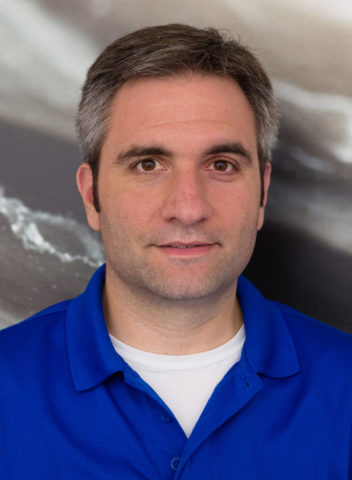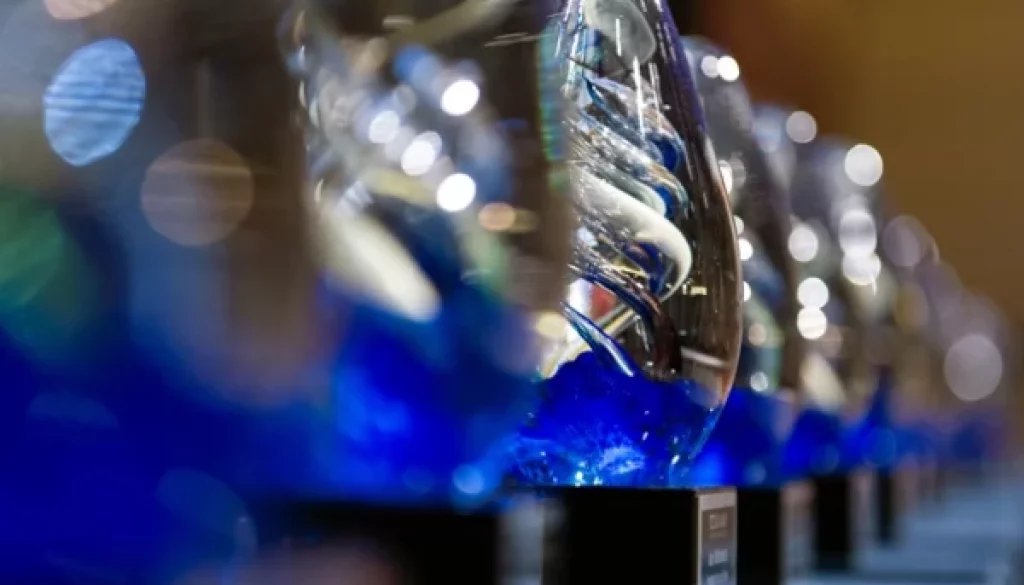Two Texas A&M Science Faculty Named 2021 Presidential Impact Fellows
Two faculty in the College of Science are among 20 Texas A&M University faculty named to the 2021 class of Presidential Impact Fellows, announced October 28 by the Office of the Provost and Dean of Faculties.
Emily Pentzer, an associate professor in the Department of Materials Science and Engineering and Department of Chemistry, and Louis Strigari, an associate professor in the Department of Physics and Astronomy, both received the coveted honor, created by Texas A&M President Michael K. Young in 2017 to recognize the continued development of and excellence in one of the university’s greatest strengths — its faculty.

The fifth official class of Presidential Impact Fellows joins more than 75 colleagues recognized in prior years with one of the most prestigious scholarly impact awards presented to Texas A&M faculty. The award was initiated by President Young as a significant investment in faculty excellence and a recognition of the scholarship, personal commitment and global impact awardees are making as they rise to meet the challenges of their field and demonstrate impact.
Each member of the 2021 class — selected from among faculty within Texas A&M’s 16 colleges and schools, two branch campuses, and comprehensive University Libraries — will receive an annual stipend of $25,000 for the next three fiscal years to accelerate their teaching, research and service efforts. In addition to retaining the title of Presidential Impact Fellow for life, each will receive a glass art memento reflecting the synergy of transformational learning, discovery and impact achieved through Texas A&M’s commitment to creating a better world.
Recipients are identified by their deans and confirmed by academic leadership. They are considered candidates for continued or new national and international acclaim and will utilize this honor to participate in national dialogue, advance their scholarship and create new partnerships.
Pentzer and Strigari join biologist Christine Merlin (2020); chemists Lei Fang (2020), Wenshe Ray Liu (2018) and Karen L. Wooley (2017); mathematicians Simon Foucart (2019) and Eric C. Rowell (2018); and physicists Rupak Mahapatra (2019), Saskia Mioduszewski (2018) and Alexei V. Sokolov (2017) as current Presidential Impact Fellows within the College of Science.
Pentzer joined the Texas A&M faculty in 2019 and, in addition to Materials Science and Engineering and Chemistry, is an affiliated faculty member in the Department of Chemical Engineering. She received her doctorate in organic chemistry from Northwestern University in 2010 and completed postdoctoral study at the University of Massachusetts Amherst, where she worked with Professor Todd Emrick on the synthesis and assembly of electronically active materials for organic photovoltaics as part of a Department of Energy (DOE) Energy Frontier Research Center on Polymer-Based Materials for Harvesting Solar Energy. Prior to coming to Texas A&M, she spent six years as the Frank Hovorka Assistant Professor of Chemistry at Case Western Reserve University (CWRU) with a secondary appointment in macromolecular science and engineering. Pentzer is a nationally recognized rising star in polymer chemistry whose dynamic and interdisciplinary research program at the intersection of science and engineering centers around designing, synthesizing and evaluating composite organic materials with diverse application in energy, healthcare, the environment and industry. For example, she currently is a co-principal investigator for a three-year, $3.6 million DOE project exploring novel direct-air capture (DAC) techniques to remove carbon dioxide from ambient air in order to help fight climate change. Other major projects include polymer-based optical data storage in a quaternary code, development of new polymer chemistries and 3D printing of multifunctional materials for sensing or thermal energy management. Pentzer is an associate editor for the Royal Society of Chemistry journal Polymer Chemistry and was elected Alternate Councilor for the American Chemical Society (ACS) Polymer Division in 2020. Her career honors to date include being named as a 2021 AZZ Inc. Faculty Fellow and a 2017 ACS Polymer Materials Science and Engineering Division Young Investigator as well as receiving the 2021 ACS Women Chemist Committee Rising Star Award, the 2019 CWRU Faculty Diversity Excellence Award, the 2017 Outstanding Professor Award for CWRU engineering groups and a 2016 National Science Foundation Faculty Early Career Development (CAREER) Award. In addition, she was selected in 2020 for the Wall of Fame at her high school alma mater, Bedford North Lawrence High School, in Bedford, Indiana.
“I am delighted that Emily Pentzer has been chosen as a Presidential Impact Fellow,” said Dr. Simon W. North, professor and head of Texas A&M Chemistry. “Not only is she a nationally recognized rising star in the area of polymer chemistry, but she is also a wonderful, dynamic colleague who has already made many valuable contributions to the Department of Chemistry and Texas A&M University. The influence and impact of her group’s diverse research portfolio and abundant potential is clear. Having invaluable support from this program at such a critical point in her career will help to ensure her bright future.”

Strigari joined the Texas A&M faculty in 2014, where he is a member of the Texas A&M Astronomy Group and the George P. and Cynthia Woods Mitchell Institute for Fundamental Physics and Astronomy. He received his doctorate in physics from The Ohio State University in 2005 and completed a postdoctoral stint at the University of California, Irvine (2005-2008) prior to spending five years at Stanford University’s Kavli Institute for Particle Astrophysics and Cosmology, initially as a Hubble Fellow and postdoctoral researcher (2008-2011) and then as a research associate (2011-2013). He began his independent career as an assistant professor at Indiana University (2013-2014) before coming to Texas A&M. Strigari’s research at the interface of particle physics, astrophysics and cosmology uses astronomical observations to study fundamental physics that is difficult to access through terrestrial experimental methods, with a particular focus on dark matter and neutrinos. He is an international expert in understanding the astrophysical properties of dark matter and widely known in the high energy physics and astronomy communities as the first theorist in the world to recognize that astrophysical neutrinos would be a fundamental limitation to direct searches for dark matter. In addition, he has played a crucial role in understanding dark matter distributions in dwarf galaxies and connecting these measurements to high energy physics experiments, such as the Fermi-LAT (Large Area Telescope) collaboration that is using high energy gamma-ray astrophysics to search for dark matter signatures. Strigari also was a key contributor to vetting and interpreting the data from the Local Group and Milky Way satellite galaxies for the Dark Energy Survey. Moreover, he was the first to suggest that astrometric measurements of stars in dwarf galaxies could place strong bounds on particle dark matter — observations that now are being performed by the Gaia satellite. His work with local collaborators motivated the development of the Mitchell Institute Neutrino Experiment at Reactor (MINER), which is housed at the Texas A&M Nuclear Science Center. Strigari’s research is funded by the DOE, NASA, the Gordon and Betty Moore Foundation and previously the NSF. He has been active in creating and organizing events that attract leading researchers from around the world, ranging from workshops at the Mitchell Institute to large conferences such as the 27th International Conference on Supersymmetry and Unification of Fundamental Interactions (SUSY 2019) in Corpus Christi. He was named a Kavli Frontiers of Science Fellow by the National Academy of Sciences in 2015 and recently selected to serve as a coordinator of the Neutrino Theory working group for Snowmass 2021, which sets the priorities for high energy physics research in the upcoming decade.
“Professor Strigari’s research is at the interface of modern cosmology and high energy physics, an exciting new direction that is poised to deliver new results on the cosmological evolution of the universe,” said Dr. Grigory Rogachev, professor and head of Texas A&M Physics and Astronomy. “His vision and scientific intuition already have led him to achieve amazing results by discovering a so-called neutrino floor — an irreducible background from coherent neutrino scattering that has to be taken into account in all direct searches for dark matter. Professor Strigari is a key link between the theoretical high energy physics and astronomy groups in the Mitchell Institute. He has been recognized as a young leader in these fields and been enormously successful. His research is tremendously impactful and highly cited. This award will further help him develop his research program and put him in an excellent position to receive prestigious, nationally competitive awards in the future.”
To learn more about faculty in the College of Science, visit http://science.tamu.edu/faculty/.
# # # # # # # # # #
About Research at Texas A&M University: As one of the world’s leading research institutions, Texas A&M is at the forefront in making significant contributions to scholarship and discovery, including science and technology. Research conducted at Texas A&M generated annual expenditures of more than $1.131 billion in fiscal year 2020. Texas A&M ranked in the top 25 of the most recent National Science Foundation Higher Education Research and Development survey based on expenditures of more than $952 million in fiscal year 2019. Texas A&M’s research creates new knowledge that provides basic, fundamental, and applied contributions resulting in economic benefits to the state, nation, and world. To learn more, visit Research@Texas A&M.
-aTm-
Contact: Shana K. Hutchins, (979) 862-1237 or shutchins@science.tamu.edu
The post Two Texas A&M Science Faculty Named 2021 Presidential Impact Fellows appeared first on Texas A&M College of Science.
